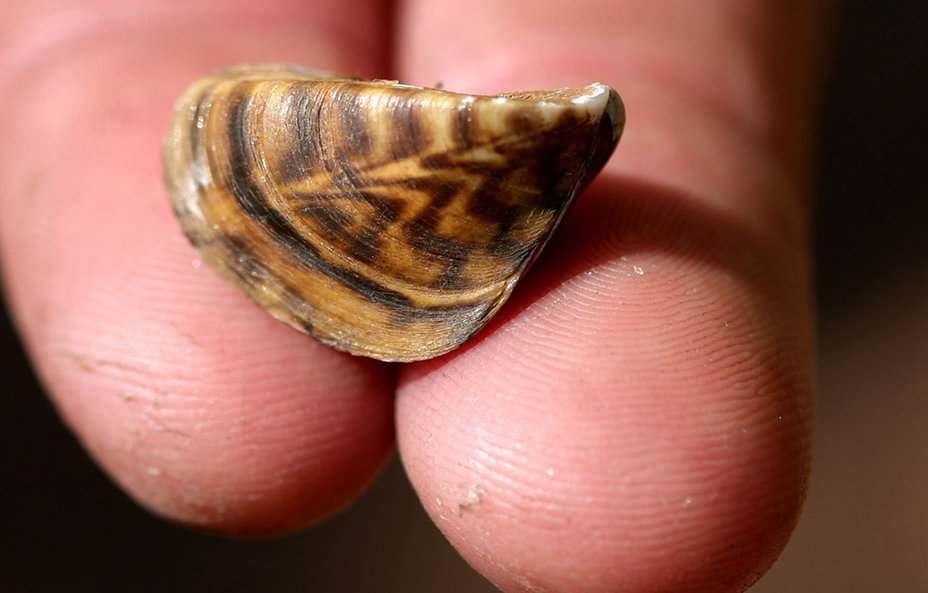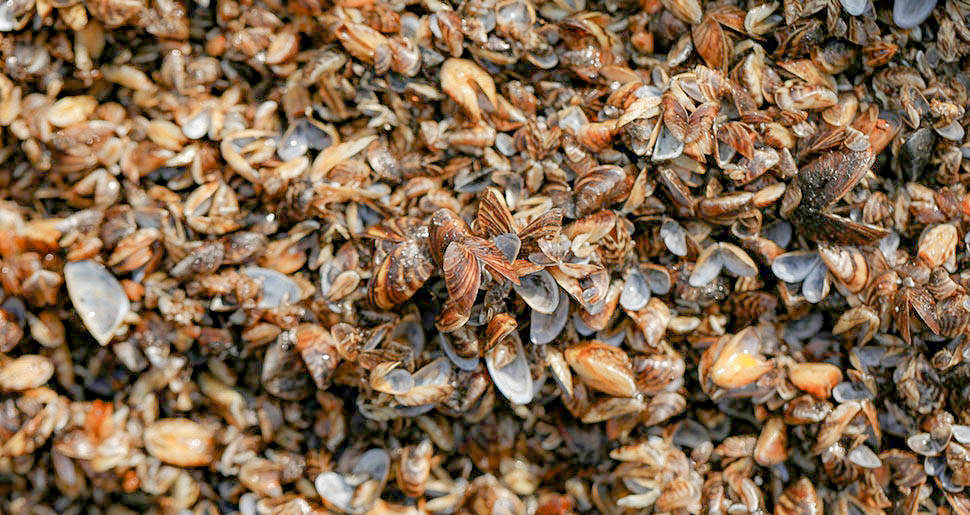Dreissena polymorpha
Zebra mussels, though small, have huge impacts on our lakes. Their presence may greatly reduce lakefront property values and their sharp shells cut swimmer’s feet. Ecologically, they filter enormous quantities of microscopic algae and alter energy flow through aquatic ecosystems—impacting fish populations and smothering and causing extinctions of native mussels. Research at MAISRC focuses on finding effective and efficient ways to control them, establishing how they're spreading to better target prevention efforts, and informing management by developing early detection methods and creating survey protocols. More about zebra mussels.
MAISRC findings
- Completed sequencing of a draft genome of the zebra mussel in order to isolate markers to study spread and explore possible genetic weaknesses that can be targeted for control
- Identified where on a boat zebra mussels may be hiding to recommend decontamination techniques and watercraft redesign options
- Established how far zebra mussel larvae can spread down small rivers and streams. Research showed that settlement of mussels occurs only a short distance down from the upstream lake. Small streams can carry large numbers of larvae, but only down short (<10 miles) stretches of streams
- Identified the lowest effective dilution of antifreeze and the shortest period of contact time required to effectively kill zebra mussels during boat winterization
- Established best practices for using EarthTec QZ, a commercially available molluscicide, to control populations by suppressing veligers
- Developed rapid response toolkit to treat localized zebra mussel infestations based on water temperature and size of infestation. The protocols provide managers with a critical support tool to swiftly select the correct molluscicide, determine the treatment concentration, and determine the treatment duration
- Developed an early detection tool that simultaneously detects the presence of zebra mussels, quagga mussels, and their microscopic larvae with just one lake water sample
Research
RNA-interference screens for zebra mussel biocontrol target genes
This project will develop methods of RNA-interference (RNAi) to identify genetic weak points in zebra mussels and to develop the tools to manipulate these critical genes as a stepping-stone towards targeted genetic biocontrol efforts.
Led by Dr. Daryl Gohl
Copper-based control: zebra mussel settlement and nontarget impacts
Researchers will use a biotic ligand model (BLM) to predict the lake-specific minimum toxic copper concentration to target zebra mussel veligers.
Led by Dr. Diane Waller
Evaluating innovative coatings to suppress priority AIS
This project will develop and test a non-toxic, new coating that can mitigate the spread of zebra mussels while minimizing non-target impacts.
Led by Dr. Mikael Elias
Public values of aquatic invasive species management
This project looks to to quantify and analyze the ecological and economic value of AIS damages and AIS management as they relate to ecosystem services such as fishing, swimming, biodiversity, and navigability.
Led by Dr. Amit Pradhananga
Early detection of zebra mussels using multibeam sonar
This study will test the utility of swath mapping systems such as multibeam sonar for detecting and quantifying the abundance of invasive mussels at a very large scale.
Led by Dr. Jessica Kozarek
A novel technology for eDNA collection and concentration
Researchers developed an eDNA filter that can screen quickly and cost-efficiently for native, invasive, and endangered species.
Led by Dr. Abbas Abdennour
Sustaining walleye populations: assessing impacts of AIS
The overall goal of this project is to assess the impacts of invasive zebra mussels and spiny water fleas on walleye in Minnesota lakes.
Led by Dr. Gretchen Hansen
Temperature-dependent toxicity of molluscicides to zebra mussels
This project created water-temperature dependent treatment protocols to eradicate localized zebra mussel infestations in a rapid response scenario.
Led by Dr. James Luoma
Decision-making tool for optimal management of AIS
This project will develop a decision-making tool to help AIS managers, counties, and other agencies prioritize their resources for optimal prevention and intervention of AIS, specifically zebra mussels and starry stonewort.
Led by Dr. Nicholas Phelps
Cost-effective monitoring of lakes newly infested with zebra mussels
This project will develop recommendations for underwater survey methods to estimate zebra mussel population abundance and distribution.
Led by Dr. John Fieberg
Metagenomic approaches to develop biological control strategies for aquatic invasive species
This project will identify and isolate microbes that are potentially pathogenic to AIS, and evaluate the specificity and effectiveness of potential biocontrol agents in the laboratory.
Led by Dr. Michael Sadowsky
Estimating overland transport frequencies of invasive zebra mussels
This study aimed to estimate the relative contributions of different surfaces and compartments on and in recreational boats and trailers to the transport of zebra mussels and their larvae (veligers), focused on measurements of the concentrations of veligers in residual water across a full range of vessel types in Minnesota.
Led by Dr. Mike McCartney
Evaluating boat cleaning station efficacy on the removal of residual water from recreational boats
This study evaluated the practicality and effectiveness of a CD3 Cleaning Station vacuum for removing residual water from various recreational boats.
Led by Dr. Nicholas Phelps
Zebra, quagga, and native mussel research efforts on the St. Croix Scenic Riverway and Apostle Islands National Lakeshore
At the St. Croix National Scenic Riverway, researchers collected zebra mussel veliger samples from throughout the riverway and analyzed them to determine population and reproduction dynamics.
Led by Dr. Michael McCartney
Genome sequencing and analysis to select target genes and strategies for genetic biocontrol
This project mapped and shared a publicly accessible genome of the zebra mussel: a powerful tool for invasion biology and biocontrol researchers in Minnesota and worldwide.
Led by Dr. Michael McCartney
Toxicity of antifreeze to zebra and quagga mussels
The goal of this project was to identify the lowest effective dilution of antifreeze at the shortest period of contact time to effectively kill adult and juvenile quagga mussels and juvenile zebra mussels.
Led by Dr. Nicholas Phelps
Recognizing high-risk areas for zebra mussels and Eurasian watermilfoil invasions in Minnesota
The goal of this project was to improve the decision-making process and prevent the spread of AIS by implementing risk-based prevention and mitigation management strategies.
Led by Dr. Nicholas Phelps
Developing and testing a new molecular assay for early detection of zebra mussel veligers
This project developed an early detection molecular assay for detecting and quantifying zebra and quagga mussel DNA in environmental mixtures of the two species.
Led by Dr. Michael McCartney
Creation of survey and monitoring protocols, and development of a research program for studying the effectiveness of zebra mussel pesticide treatment efforts
In partnership with the Minnesota DNR Invasive Species program, MAISRC provided a description of the Pilot Project Program and the application process to obtain a permit for treating newly infested lakes.
Led by Dr. John Fieberg
Evaluating zebra mussel spread pathways and mechanisms in order to prevent further spread
This project focused on preventing zebra mussel invasions by developing genetic evidence of spread sources and pathways so that they may be interrupted. It also lays the groundwork for potential biocontrol through genetic modification technologies.
Led by Dr. Michael McCartney
Eco-epidemiological model to assess aquatic invasive species management
MAISRC researchers are working to develop a first-of-its-kind eco-epidemiological model that will forecast the potential risk of spread of zebra mussels and starry stonewort across Minnesota.
Led by Dr. Nicholas Phelps
About zebra mussels
Description
Zebra mussels are ¼-1 ½ inch-long bivalve (2-shelled) molluscs. They evolved from ancestors similar to surf clams (used to make clam chowder) that invaded fresh waters in southern Russia. They have a D- or wedge-shaped shell, which is often marked by alternating brown and yellow bands in a zigzag pattern. They live on lake and river bottoms, rocks, aquatic plants, docks, lifts, and boats to which they attach using small dark fibers called "byssal threads." Viewed up-close underwater, two tiny siphons can be seen projecting into a narrow gap between the shell valves of each animal — these siphons are used to pump water for respiration and feeding.
Life cycle
Zebra mussels are ¼-1 ½ inch-long bivalve (2-shelled) molluscs. They evolved from ancestors similar to surf clams (used to make clam chowder) that invaded fresh waters in southern Russia. They have a D- or wedge-shaped shell, which is often marked by alternating brown and yellow bands in a zigzag pattern. They live on lake and river bottoms, rocks, aquatic plants, docks, lifts, and boats to which they attach using small dark fibers called "byssal threads." Viewed up-close underwater, two tiny siphons can be seen projecting into a narrow gap between the shell valves of each animal — these siphons are used to pump water for respiration and feeding.
Impacts
Zebra mussels cause economic harm in North America of over one billion dollars per year. Their huge populations attach to hard surfaces, clog intake pipes for water treatment and power generating plants, encrust boat motors and hulls, may greatly reduce lakefront property values, and their sharp shells cut swimmer’s feet. Ecologically, they filter enormous quantities of microscopic algae and alter energy flow through aquatic ecosystems — with potentially large impacts on fish populations — and they smother and cause extinctions of native bivalve mollusks.
Distribution
Zebra mussels are native to large rivers and lakes draining into the Black, Caspian, and Azov Seas of southwestern Russia and the Ukraine. Beginning in about 1800, they began spreading across western and northern Europe and most recently have reached inland waters in the British Isles, Spain, Portugal, and France. They appeared in North America in 1988, and in five years they spread rapidly throughout the Great Lakes and large rivers. In several Great Lakes (particularly Michigan and Erie) zebra mussels have been largely replaced by a related species — the quagga mussel (D. bugensis) — also from the Black Sea. Zebra mussels arrived in the Duluth Harbor in 1989 and the Mississippi River in 1993. As of May 2018, the Minnesota Department of Natural Resources listed 335 waterbodies in the state as infested due to either confirmed zebra mussel presence or connection to a waterbody with a confirmed presence.
How they spread
In the 19th century, zebra mussels spread throughout Europe in man-made canals, and in the late 20th century, on recreational watercraft and the nets of commercial fisherman. They were also spread to lakes in Poland and Belarus on the nets of commercial fisherman. In North America, barge traffic and (to unknown extent) larval dispersal were responsible for rapid initial spread throughout the Great Lakes, Mississippi, Ohio and Susquehanna Rivers. Spread to inland lakes has occurred by larvae transported down connected streams and waterways, and overland via mussels attached to vegetation and to surfaces of recreational boats, trailers, docks and lifts. Veliger larvae may also be transported in the "residual water" remaining inside boat compartments when trailered boats are moved between waterways.


